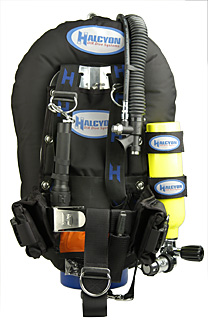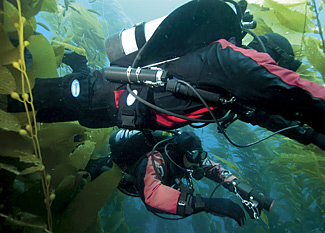Hey, Jason!
There's two ways to deploy the light - one, the simplest method, is to grab the light head and pull away from the body. The inner tube will slide up the light body and over the bolt snap on it's own (zero effort). Twist the light head to make it turn on, and then you can either use it with the bolt snap connected to the D-ring (if you're worried about dropping it), or remove it from the D-ring completely at that point (if you really need the light to be free). The idea is to have the light on before unclipping the D-ring, just in case you drop it. That way, if you lose the light, it'll at least be "on" so it should be easier to find and if it was "off."
An alternative method for deployment is to run the backside of your thumb (same side - right hand for right light and left hand for left light) down the light body (from the bolt snap to the light head) so that it catches the inner tube. This will work with all but the very heaviest of gloves. Once you catch the inner tube, you can pull it out and over the light head (I use my fore and middle fingers of the same hand to push upwards on the light "head"), which will allow the light to drop out and dangle freely on it's bolt snap. Twist the head to turn on, then unclip the light or use while connected to the D-ring.
Both methods work equally well - when I'm in a hurry or feeling lazy or need a light NOW, I just pull it away from my body, which slides the inner tube up the light body. One twist, and it's on and I've got light.
Restowing is simply a matter of untwisting the head to turn it off, then sliding the inner tube down the body to make it sit flush against the webbing - or using two hands (one to open the inner tube and the other to stow the light) if I used the second method of deployment.
(Don't tell my DIR buddies, but sometimes I get lazy and just worry about restowing the light after the job is done and I'm either headed out of the water or back on the boat/dry land.

)
These actions, while textbook GUE/DIR mantra, aren't really something that I bother to think about... It's more like, "Hey, I need a light. Gimme a light," not, "Let's practice the right method of light deployment."

Interestingly, after you do it a few times, it gets to be pretty much second nature... And either light can be deployed by either hand pretty easily, which is really great when you've already got your hands full with a scooter, reel, tools, buddy, fossils, dead bodies, etc.

For the same reason, I keep my cutting tool (I find a knife more useful than scissors) in the center of the belt portion of my harness. It's easily accessible with one hand... And either hand.








